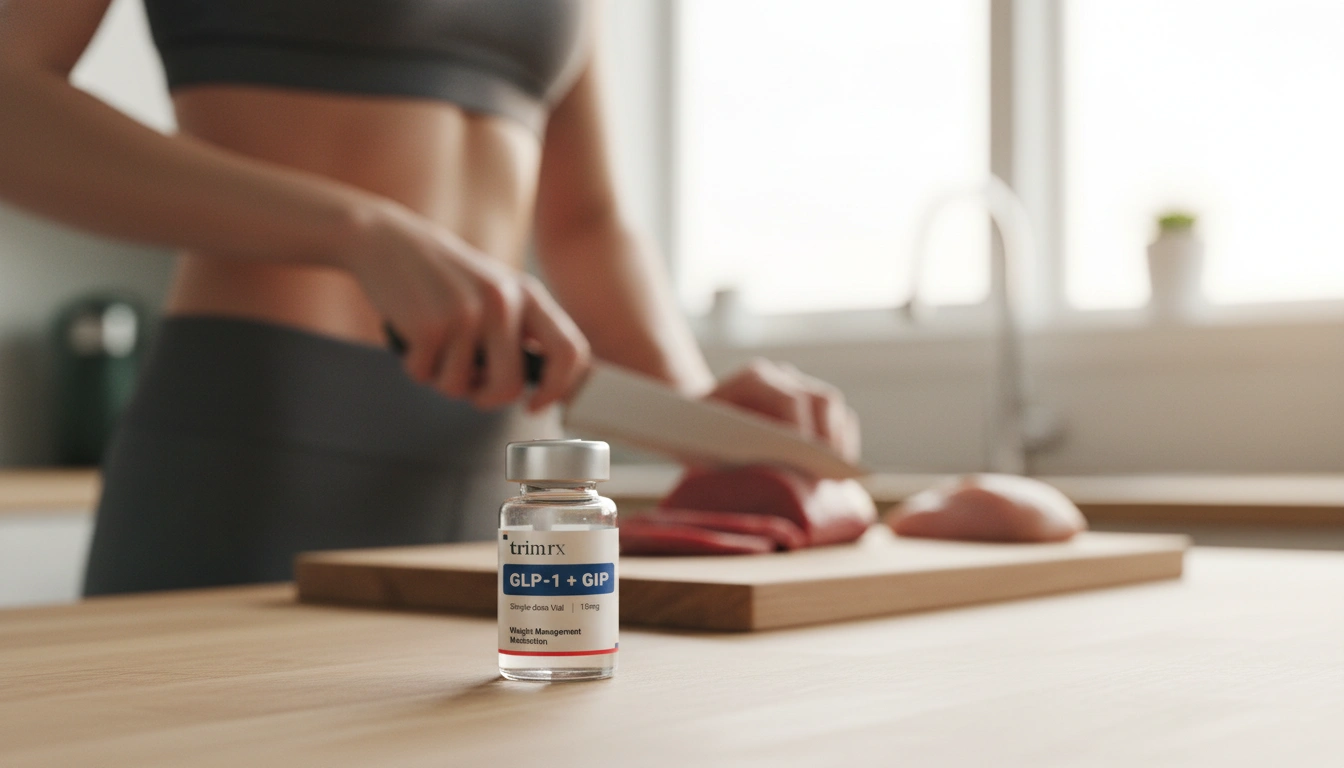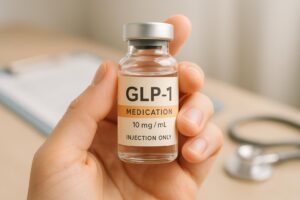How to Deal with GLP-1 Nausea: Strategies for Navigating Side Effects

Introduction
Have you ever felt that unsettling wave of nausea creeping in after a meal? If you’re one of the many individuals who have started using GLP-1 medications for weight management or to help control type 2 diabetes, you might be all too familiar with this sensation. Nausea is one of the most commonly reported side effects of GLP-1 receptor agonists like Ozempic®, Wegovy®, and Mounjaro®. While it can feel daunting, understanding how to manage this side effect can significantly enhance your experience with these medications.
At TrimRx, we recognize that embarking on a weight loss journey with the help of GLP-1 medications can be both exciting and challenging. This blog post aims to provide you with insights on how to deal with GLP-1 nausea effectively, ensuring that you feel empowered and supported every step of the way.
We will explore the underlying reasons for nausea when using GLP-1 medications, practical strategies to alleviate discomfort, and lifestyle adjustments that can make your journey smoother. By the end, you’ll have a clearer understanding of how to navigate this side effect, allowing you to focus on your weight loss goals with greater confidence.
What You Will Learn
- The reasons behind nausea while using GLP-1 medications
- Practical tips for alleviating nausea
- Dietary adjustments that can help reduce nausea
- The importance of open communication with your healthcare provider
- How to maintain your overall health and well-being during your weight loss journey
Let’s dive into the world of GLP-1 medications and explore how we can transform the experience of nausea into manageable steps towards achieving your health goals.
Understanding GLP-1 and Nausea
GLP-1 (glucagon-like peptide-1) medications are designed to mimic the body’s natural incretin hormones, which play a crucial role in regulating appetite, food intake, and insulin secretion. While these medications can significantly aid in weight loss and glycemic control, they can also affect the gastrointestinal (GI) system, leading to nausea.
Why Does Nausea Occur?
Nausea is often a result of the way GLP-1 medications influence gastric emptying. By slowing down the rate at which food leaves the stomach, these medications can lead to a feeling of fullness that is more pronounced than usual. This mechanism, while beneficial for appetite control, can sometimes result in discomfort or nausea, especially in the early stages of treatment or after dosage adjustments.
According to research, nausea is particularly common during the first few weeks of treatment and when increasing dosages. While experiencing nausea can be disheartening, it’s important to understand that this side effect typically decreases over time as your body adjusts to the medication.
Is Nausea a Good Sign?
Interestingly, mild nausea can indicate that the medication is working as intended. It can serve as a signal that your appetite is being suppressed, which is often a desired effect for those aiming to lose weight. However, there is a fine line between manageable nausea and debilitating discomfort. If nausea interferes with your daily activities or leads to a significant decrease in food intake, it’s crucial to take proactive steps to address it.
Practical Tips for Alleviating Nausea
Navigating nausea while on GLP-1 medications doesn’t have to be a solitary journey. Here are several practical strategies that can help ease your discomfort:
1. Eat Smaller, More Frequent Meals
One of the most effective ways to manage nausea is to eat smaller portions spread throughout the day instead of large meals. This approach can prevent overwhelming your stomach and reduce the likelihood of nausea.
- Actionable Tip: Aim for five to six small meals daily rather than the traditional three large meals. This can help your digestive system cope better with the medication’s effects.
2. Choose Bland, Low-Fat Foods
Foods that are bland and low in fat are generally easier on the stomach and less likely to trigger nausea. Consider incorporating foods like:
- Plain toast or crackers
- Rice or pasta
- Bananas and applesauce
- Steamed vegetables
- Actionable Tip: Avoid spicy, greasy, or high-sugar foods, as they can exacerbate nausea.
3. Stay Hydrated
Hydration is key when dealing with nausea. However, it’s essential to sip fluids rather than gulping them down, as large amounts can sometimes worsen nausea.
- Actionable Tip: Aim to drink at least 64 ounces of water daily. Consider ginger or peppermint teas, as these can be soothing for the stomach.
4. Monitor Your Diet
Keeping a food diary can help you identify which foods or eating patterns contribute to your nausea. Documenting what you eat and how you feel afterward will provide valuable insights into your triggers.
- Actionable Tip: Note any symptoms after meals, and share this information with your healthcare provider to adjust your diet accordingly.
5. Consider Medication Support
If your nausea persists or becomes severe, don’t hesitate to seek guidance from your healthcare provider. They may recommend anti-nausea medications that can help alleviate your symptoms.
- Actionable Tip: Discuss options like Zofran with your provider, especially if nausea is significantly impacting your daily life.
6. Adjust Your Dose Gradually
One common mistake is wanting to increase the dose of GLP-1 medications too quickly. Gradual adjustments can help your body acclimate without overwhelming your system.
- Actionable Tip: Communicate with your healthcare provider about your experience and consider remaining at a lower dose longer to allow your body to adjust.
Lifestyle Adjustments for Managing Nausea
Alongside dietary changes, certain lifestyle adjustments can further minimize nausea and enhance your overall experience while on GLP-1 medications.
1. Engage in Gentle Physical Activity
Light physical activity, such as walking, can aid in digestion and alleviate feelings of nausea. Strive for gentle movement rather than strenuous exercise, especially right after eating.
- Actionable Tip: After meals, take a short walk to support digestion and clear your mind.
2. Practice Mindfulness and Relaxation Techniques
Stress can exacerbate nausea. Incorporating mindfulness practices, such as deep breathing or meditation, can help calm your mind and body.
- Actionable Tip: Dedicate a few minutes each day to mindfulness exercises, especially during moments of discomfort.
3. Timing Your Dose
Consider timing your medication doses strategically around your daily activities. For example, if you anticipate feeling more nauseous after injections, consider scheduling them on days when you have fewer commitments.
- Actionable Tip: If possible, take your dose on a weekend or during a time when you can rest afterward.
Communicating with Your Healthcare Provider
Open communication with your healthcare provider is vital throughout your weight loss journey. If you experience persistent nausea or any other concerning symptoms, it’s essential to reach out. Your provider can help adjust your medication or recommend additional strategies tailored to your unique needs.
Questions to Discuss with Your Provider
- What is the expected duration of nausea while on this medication?
- Are there specific foods I should avoid?
- What should I do if the nausea becomes severe or leads to vomiting?
- How can we adjust my dosage to better manage side effects?
Conclusion
Managing nausea while on GLP-1 medications can be challenging, but with the right strategies and support, it is entirely feasible. By implementing practical dietary adjustments, staying hydrated, and maintaining open communication with your healthcare provider, you can navigate this side effect effectively.
At TrimRx, we are dedicated to providing personalized, medically supervised weight loss solutions that empower you on your health journey. Together, we can work towards achieving your weight loss goals without unnecessary discomfort.
FAQ
How long does nausea last when starting GLP-1 medications?
Nausea can vary from person to person, but it typically decreases after the initial weeks of treatment as your body adjusts to the medication.
Are there specific foods that can help reduce nausea?
Yes, bland, low-fat foods such as toast, rice, and bananas are often easier on the stomach and can help reduce nausea.
When should I contact my healthcare provider about nausea?
If nausea becomes persistent, severe, or leads to vomiting, it’s crucial to reach out to your healthcare provider for guidance and possible medication adjustments.
Can I continue my exercise routine while experiencing nausea?
Gentle physical activity, like walking, is generally acceptable and can help with digestion, but listen to your body and avoid strenuous activities if you feel unwell.
Is it normal to feel nauseous after increasing my medication dose?
Yes, nausea can be more pronounced when increasing doses, so it’s important to adjust gradually and communicate your experiences with your healthcare provider.
By embracing these strategies, you can take control of your health and focus on your goals with confidence. Remember, you’re not alone on this journey, and we’re here to support you every step of the way!

Transforming Lives, One Step at a Time
Keep reading
Tracking Progress With GLP-1: What To Measure
Learn which metrics to track on GLP‑1 therapy—weight, waist, blood sugar, lipids, side effects, and non‑scale wins—and how often to monitor them.
Fatigue Solutions for Ozempic and Wegovy Users
Hydration, protein-rich meals, light activity, and better sleep can reduce medication-related fatigue and help maintain energy during weight-loss treatment.
GLP-1 Medication Side Effect Checker
Worried about GLP-1 medication side effects? Use our free checker for Semaglutide, Liraglutide, and more to learn what to expect and stay informed!



